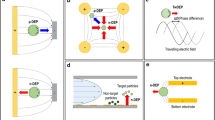Abstract
In this article, a cell sorter with a simplified structure is presented. This sorter harnesses negative dielectrophoretic (n-DEP) force and gravity. In order to enhance the throughput and recovery rate, a meso-sized (15 mm×40 mm×200 μm) channel assembled with two transparent plates and two side walls is employed. Since a complex structure would degrade the cell sorter’s performance due to the leaking phenomenon as well as cell adhesion, the structure of the proposed sorter is simplified by minimizing the number of components. In addition, microelectrode arrays are designed with five continuous microelectrode pairs. This configuration utilizes continuous separation at each electrode pair, thereby enabling greater separation efficiency. As the drag force, gravity and n-DEP force are the principal parameters of the cell sorter, they are evaluated around the DEP barrier. Subsequently, based on the numerical simulation and theoretical results, separation conditions are experimentally investigated. Consequently, 7 Vp-p at 10 kHz is selected as the input condition. In order to evaluate the cell sorter, K562 cells − cancer cells found in bone marrow − are selected for use as target cells. In the experiments, a separation efficiency of 94.74±0.77%, a throughput of 17,000 cells/min and a recovery rate of 49.42% are achieved.
Similar content being viewed by others
References
Saeed, O. O., Li, R., and Deng, Y., “Microfluidic Approaches for Cancer Cell Separation: Review,” Journal of Biomedical Science and Engineering, Vol. 7, No. 12, Article ID: 1005, 2014.
Lacombe, F. and Belloc, F., “Flow Cytometry Study of Cell Cycle, Apoptosis and Drug Resistance in Acute Leukemia,” Hematology and Cell Therapy, Vol. 38, No. 6, pp. 495–504, 1996.
Amor, K. B., Breeuwer, P., Verbaarschot, P., Rombouts, F. M., Akkermans, A. D., et al., “Multiparametric Flow Cytometry and Cell Sorting for the Assessment of Viable, Injured, and Dead Bifidobacterium Cells during Bile Salt Stress,” Applied and Environmental Microbiology, Vol. 68, No. 11, pp. 5209–5216, 2002.
Meinhardt, K., Kroeger, I., Mueller, S., and Ullrich, E., “Mouse NK Cells Isolated to High Purity by MACS® Technology are Fully Functional,” MACS&more, Vol. 15, No. 1, pp. 28–30, 2013.
Tsutsui, H. and Ho, C. M., “Cell Separation by Non-Inertial Force Fields in Microfluidic Systems,” Mechanics Research Communications, Vol. 36, No. 1, pp. 92–103, 2009.
Zhu, H., Lin, X., Su, Y., Dong, H., and Wu, J., “Screen-Printed Microfluidic Dielectrophoresis Chip for Cell Separation,” Biosensors and Bioelectronics, Vol. 63, pp. 371–378, 2015.
Song, H., Rosano, J. M., Wang, Y., Garson, C. J., Prabhakarpandian, B., et al., “Continuous-Flow Sorting of Stem Cells and Differentiation Products based on Dielectrophoresis,” Lab on a Chip, Vol. 15, No. 5, pp. 1320–1328, 2015.
Lee, D. and Kim, B., “A Cell Sorting System for the Evaluation of Drug Sensitivity using Negative Dielectrophoresis,” Int. J. Precis. Eng. Manuf., Vol. 16, No. 3, pp. 609–613, 2015.
Gascoyne, P. R., Wang, X. B., Huang, Y., and Becker, F. F., “Dielectrophoretic Separation of Cancer Cells from Blood,” IEEE Transactions on Industry Applications, Vol. 33, No. 3, pp. 670–678, 1997.
Ducommun, P., Kadouri, A., Von Stockar, U., and Marison, I. W., “On-Line Determination of Animal Cell Concentration in Two Industrial High-Density Culture Processes by Dielectric Spectroscopy,” Biotechnology and Bioengineering, Vol. 77, No. 3, pp. 316–323, 2002.
Choi, E., Kim, B., and Park, J., “High-Throughput Microparticle Separation using Gradient Traveling Wave Dielectrophoresis,” Journal of Micromechanics and Microengineering, Vol. 19, No. 12, Paper No. 125014, 2009.
Morgan, H. and Green, N. G., “AC Electrokinetics: Colloids and Nanoparticles,” Research Studies Press, pp. 15–54, 2003.
Ron, A., Singh, R. R., Fishelson, N., Shur, I., Socher, R., et al., “Dielectric Dispersion of Suspended Cells using 3D Reconstructed Morphology Model,” Bioelectrochemistry, Vol. 75, No. 2, pp. 95–103, 2009.
Gascoyne, P. R., Shim, S., Noshari, J., Becker, F. F., and Stemke-Hale, K., “Correlations between the Dielectric Properties and Exterior Morphology of Cells Revealed by Dielectrophoretic Field-Flow Fractionation,” Electrophoresis, Vol. 34, No. 7, pp. 1042–1050, 2013.
Shim, S., Stemke-Hale, K., Noshari, J., Becker, F. F., and Gascoyne, P. R., “Dielectrophoresis has Broad Applicability to Marker-Free Isolation of Tumor Cells From Blood by Microfluidic Systems,” Biomicrofluidics, Vol. 7, No. 1, Paper No. 011808, 2013.
Author information
Authors and Affiliations
Corresponding author
Rights and permissions
About this article
Cite this article
Lee, D., Hwang, B., Choi, Y. et al. Negative dielectrophoretic force based cell sorter with simplified structure for high reliability. Int. J. Precis. Eng. Manuf. 17, 247–251 (2016). https://doi.org/10.1007/s12541-016-0032-x
Received:
Revised:
Accepted:
Published:
Issue Date:
DOI: https://doi.org/10.1007/s12541-016-0032-x



